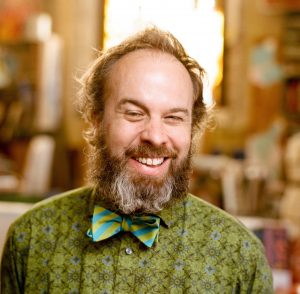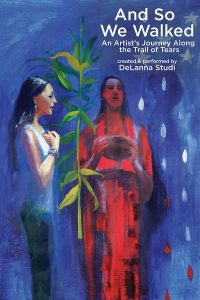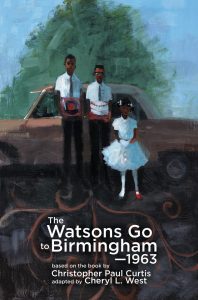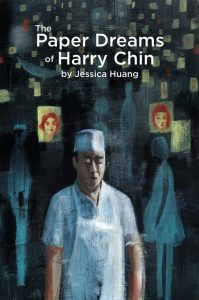
Kyle Ragsdale – Courtesy of Jonathan Frey. Used with permission.
The Indiana Repertory Theatre commissions Indianapolis artist Kyle Ragsdale to create original paintings for each of its shows to use for marketing and playbills. Having been a long-time fan of Ragsdale’s distinctive work, I was curious about his collaboration with the IRT, one of two with local theatre groups. Ragsdale is also the scenic designer for Summer Stock Stage, a summer theatre program for Central Indiana teens.
“What thrills me about Kyle is his ability to relate the content and nuance of a play into a visual form,” said IRT Artistic Director Janet Allen. She described their collaboration as “amazingly easy,” and perhaps unique, in that she is unaware of any other theater that uses local fine artists in the same manner as IRT. “He likes a lot of conversation about what we’re looking for and then he goes away and makes magic on canvas. We eagerly anticipate his creation, but he’s also very easygoing about what doesn’t work. It’s not often that one finds a fine artist with the breadth of skills and willingness to make art that is fairly specific to what we need and also has the immense skill that he brings to his own work. I always find his art very dramatic and very story-filled, even when he isn’t making work for us.”

Courtesy of Indiana Repertory Theatre. Used with permission.
Indeed, Ragsdale is a storyteller. His artist statement reads “My work is a collection of symbols. Figures, birds, flowers, foliage and envelopes function like text to trigger responses and connections. In these paintings I invite viewers to make their own interpretations and connections with the visual clues in the images. Like moments in time, memories and dreams, the figures and images serve as starters for dialogue with the viewer.”
“Kyle has been working for SSS since our very first summer in 2004,” said Summer Stock Artistic Director Emily Holloway Ristine. “Over the years, he has done scenic design, set painting, built props, painted drops, and even directed the shows. He loves to think outside the box and reinvent ways to tell the story. We always joke with the students that he is the nicest person on our team. He is a natural encourager, so he loves to tell the students how great they are and how much he is enjoying their work.”
I sat down with Ragsdale in his Harrison Center for the Arts studio for an interview. Here is an edited transcript of our discussion, along with some comments he shared with me via email.
How many seasons have you created paintings for?
The upcoming one is my seventh.
How long does it take to create them?
This group took a little longer than normal. I started in December and finished mid-March. There were a few plays I painted multiple times.
Which one took the longest?
I think “Morning After Grace” took the most time. I made four different paintings, trying to get just the right one.
Tell me about your collaboration with IRT.
I really love it so much. I enjoy reading the plays a year in advance and imagining what they will be like. I was so looking forward to seeing “A Doll’s House, Part 2” this season after reading it. We try to see all the plays. It’s really nice to see the posters as you walk into the grand old theatre.
What eventually happens to the paintings?
IRT auctions them at its annual Celebrity Radio Show.
How has the IRT gig helped the sales of your usual work?
The IRT work has made a difference and more people know my work because of the plays. It’s fun on First Fridays to talk to people who come into my studio and know my work from the theatre.
How did the collaboration begin?

Courtesy of Indiana Repertory Theatre. Used with permission.
Janet was in my studio for a First Friday. I told her, “If you ever want to think about having a painting on the program cover, I would like to explore that.” Eventually, we did meet and talk about it. It is a really fun collaboration. You don’t want to give away too much, but you want to give some idea what the play is about and express it to people who may want to see it. What do they want to say and how do they want to tell the story? I work with the ad department to basically determine what theatre wants to sell. It’s challenging. Sometimes the ad has to go horizontal or vertical and has to fit on the playbill and sometimes it even ends up on a bus.
Are you given artistic control?
No. It’s very back and forth. Sometimes, I have to paint something four or five times. Sometimes, I have about 10 rejects. Sometimes, what I am thinking and what they are thinking comes together right away. Usually, I paint something, send it along, then people respond back and I tweak some things. As far as artists go, I am more on the flexible side.
So you are not the temperamental type?
(Laughs) I am definitely not that guy. When I am working for a client, I want to try and give them what they need. A theatre is completely collaborative. Nobody ever gets everything they want, except maybe the director. But even with that, you are working with other people who have different personalities. Everyone has a vision going in, but it needs to coincide with that of the theatre itself. It is ultimately the director’s vision, but all these people are bringing strengths to it. You all have to bend a little to get the final product and it changes all the time. That kind of prepared me for this. This art for IRT needs to function in a lot of different ways. It’s what draws people in and what they see from the street.
Do you know any other artists who design sets?
I don’t know a lot of people who do both. I think my work lends itself to theatrical things because it evokes. It doesn’t tell you everything. It’s not super clear. It kind of infers, but leaves a lot to the imagination, which I think works well with theatre. There are always figures in my work.
What brought you to Indy?
I had a friend from Baylor University who had a house here and when I finished grad school at Southern Methodist University, he said, “Come up here and you can paint in my garage.” I arrived in Indy in 1993 and that was a great time to get here. I have been able to thrive as an artist and make a living off my art.

Courtesy of Indiana Repertory Theatre. Used with permission.
What has been your recipe for success?
I feel like everybody has their own system. Each artist makes their own rules and you are your own entrepreneur, really. I tried, early on, to show my art as many places as I could. If someone wanted me to have a show in a restaurant or a coffee shop or wherever, I would just try things. At one time, I went to the Bread & Puppet Theatre in northern Vermont. Their idea was that art should be for the people and that all people should be able to have art. It should not be just for the wealthy. So, I have tried to maintain the balance that maybe normal people should be able to afford my art. I try to keep the prices maybe not as high as other people’s, but I also want to make a living. For as long as I have been painting and the success I have enjoyed, my prices probably should be higher, but I also want my friends to be able to afford my work. I try to achieve some balance. I work all the time. I paint a lot and make a lot of art. I have a short attention span and keep changing things all the time.
How did your work with Summer Stock come about?
I have been friends with the Holloway/Ristines for a while. Emily’s husband Ben was in my wedding. I knew Ben before they got married, so it goes way back, but when Emily started the program, I did the first season, so I have been there all along. Back in those days, it was kind of like “The Little Rascals.” Let’s put on a show! Emily’s husband and I went to junkyards, looking for a car for “Grease.” We did everything and now there is a big team doing a whole bunch of great things. It’s a really fun team to work with and has really evolved. I think it is really exciting and I think Summer Stock Stage is kind of like the all-star team, like you have in sports. These kids find a family, camaraderie with other kids. They might be the only kid at their school who is into theatre, but when they are involved with SSS, they are surrounded by kids like them. I think it is really wonderful for them. Emily really has an awesome way of running it like a professional theatre, in that she expects a lot from people. They do the shows, like “Secret Garden,” in 17 days, so it is almost like the practice time of a professional theatre, so they have to come with a lot. They bring a lot. Rather than directing every step, every movement, she is building actors who bring stuff from themselves, which is really awesome.
Back to the IRT, what impact do you think your paintings have made in the larger sense?
James Still, the IRT playwright-in-residence, told me a story. There was a painting last season for a show called “Miranda” in which there was a woman wearing a hijab. He said he was walking out of the theatre one day and saw two young girls with hijabs taking their picture in front of it. This was during a period time when they might have felt threatened and to James, it seemed like the image might have helped them feel more welcome in this city. What an awesome thing. I think that theatre does that, but this art can do that too. When between 700 and 1,000 people come through our building here at the Harrison every First Friday and some say, “We saw your work at the theatre and we just came to check this out.”
Beyond your artist statement what do you want people to know about your work?
There is a headline on my website that reads, “I paint art that lives with people.” That narrows it down, I think. I am trying to make work that people enjoy as part of their family, part of their experience. When you go into a house that has a painting of mine and they have had it for a while, it is part of their everyday life. They walk by it on the way to breakfast. If my art can live with people and bless them and make their life more wonderful, that’s awesome. Some people want to have their work in a museum or to shock people or make a statement or advance some political agenda. I don’t think like that. Mine is more about enhancing your everyday existence.
For more information about Ragsdale, visit kyleragsdale.com. For tickets and information, about Indiana Repertory Theatre and its 2019-2010 season, visit irtlive.com. For tickets and information about Summer Stock Stage and its 2019 summer season, visit summerstockstage.com.





